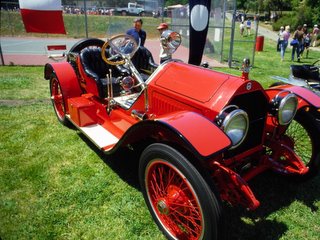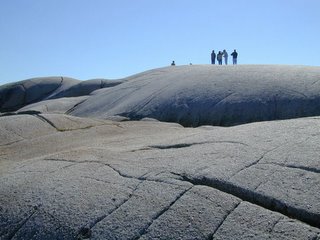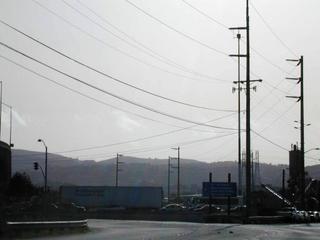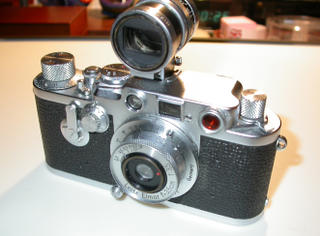Monday, October 31, 2005
Enough already
Basically
At the end of the day
In terms of
24/7
The fact is
The fact of the matter is
In point of fact
At this point in time
Pushing the envelope
Bottom line is …
Second of all
Hidden agenda
NIMBY
No doubt in my mind
Gimme a break
Proactive
Cutting edge
State of the art
World class
Boots on the ground
Heads up
Wake up call
Thinking out of the box
Between the lines
Window of opportunity
Sooner rather than later
Any way shape or form
Bring closure to …
Hasta la vista, baby
-
Sunday, October 30, 2005
Travel and Statues
A photograph accompanying the newspaper article shows a boy riding his bicycle past statues of Portuguese explorers, against a backdrop of palm trees and a brilliant blue sky.
It is the statues that drew my attention, for they so closely resemble the one of Pedro Álvares that stood (still stands?) on the Praia Grande in the Special Administrative Region of Macau in China. The statues are in a style that might have originated in the 1940s or 1950s under the Salazar dictatorship of Portugal. Indeed the statues in São Tomé and Macau might have been the work of the same sculptor, or might have come from the same Lisbon workshop, as others I have seen.
They are almost cartoonish in their stylization, and in their granitic larger-than-lifesize bulk, steely horizonward gaze, pageboy-bob haircut. Think Prince Valiant in stone, strong-jawed, with the heavy cloak of a Soviet soldier-hero, standing tall in sturdy boots, a weapon or a scroll tucked under one broad-sleeved arm. Heroic poses are common to monuments, but the Portuguese colonial empire seemed to have reached the very pinnacle when it came to heroic poses.
In the old days in Macau, that tiny blip on the China coast that today is a gambling mecca soon to rival Las Vegas, there were heroic statues galore. The main square in front of the Leal Senado building, now cobbled in wavy patterns in black and white that can give unsuspecting visitors a case of mal-de-mer, there once upon a time stood the bronze statue of the Macanese hero, Vicente Nicolau de Mesquita, drawing his sword to do battle against the Chinese at Passaleão, just across the Macau border.
During the tumult of Mao's Cultural Revolution, the city fathers (then Portuguese), were obliged to remove the offending effigy.
In its place there is now a fountain of sorts.
Sic semper transit … whatever.
-
Saturday, October 29, 2005
Death in the Afternoon
We decided in late afternoon to drive to the Stanford Shopping Center in Palo Alto. My wife loves to shop there. Well, really, she loves to shop everywhere, but Stanford happens to be one of her favorite shopping places.
To join Interstate 280 southbound from Highway 92 one has to drive through a curved highway underpass at the interchange. This tunnel-like structure is perhaps a couple of hundred yards long, two lanes wide going one way, well lit even during the day. Cars usually travel through it at high speeds, if for no other reason than that radio reception is blocked by all that concrete and earth surrounding it. I have had cars pass mine on the right at eighty miles per hour. Crazy drivers.
So here we are traveling along at a good clip, oh, at about the speed limit, I would guess. Just as we are about to emerge from the tunnel into the late afternoon sunlight, suddenly there appears ahead of us a couple of jackrabbits. One makes it to safety easily, hopping into the shadows on the left. I can still see its mate, long ears upright, frozen in silhouette against the sunlit road ahead. Instead of leaping forward to join its companion, it suddenly backtracks, hesitates, and immediately I hear a bump beneath the car.
It's dead, I know. I have taken the life of a creature in one split second, willy nilly. Let me rephrase that, so as to absolve myself of blame. I have been the unwitting agent of the untimely demise of another living creature. The jackrabbit was wrong to hesitate and to backtrack. It could have gone forward, like its mate. Why did it do this dumb thing — hopping directly under the left front tire? No way could I have avoided hitting it. I could not have swerved in time. And if I had swerved, I might have hit one of the speeding vehicles on my right.
As far as I know, I had never before knowingly caused the death of anything larger than a housefly or a yellow jacket. But this jackrabbit made an definite impression on me. Maybe it was the unexpectedness of the incident, or the fact that the bump under the car reminded me of the pivotal scene in the Krzysztof Kieslowski movie "Red" when Irene Jacob's car hit the judge's dog, or my wife asking 'What was that?'
But for the next seven or eight miles I could not get the image out of my mind of this dead jackrabbit, the first road kill I had ever made in my life.
.
Wednesday, October 26, 2005
Technology and Togetherness
For many years I have made recordings, either on film or on electronic media, of the everyday activities of family members and friends. These were usually made candidly at gatherings — birthday parties, Christmas and other holidays, vacations and the like — or formally, when the subjects were aware that I was filming or taping, and spoke directly into the camera. Some people do this more easily than others, who may feel awkward or unsure when looking into a camera lens. I try to put the subject at ease with a joke. But, to be quite honest about it, this may or may not work, and it depends a lot on their comfort level when in the intimidating presence of a camera.
Still, ten or twenty years afterwards, when an opportunity arises for me to show the film — or more likely these days, the video — to the people who appear in it, they are generally delighted to see themselves, awkward or not, as they were years before. This is especially true of images of children shown to their grown-up selves.
This is what technology can do. It can capture a moment, or long sequences of moments. Capture and preserve them. It can, in a way, stop time.
It began with early still photography — glass plates, lengthy exposures, cumbersome equipment. The photographs were static, often posed. Then photography evolved to include miniature cameras. Movies had came along — this marvelous technology that has made such great strides over the past century, and made Hollywood (ugh!) almost as synonymous with America as Wall Street in the perceptions of non-Americans.
Electronics have now made capturing live action so much easier than it had ever been. Lasers and plastics added into the mix have now given us the ability to easily preserve all of those precious moments which in the early days required the use of photographic film. Easily preserve, as well as easily share. I'm speaking of the dvd, or 'digital versatile disc', big brother of the cd, or 'compact disc' that is used to contain our music.
Computers with non-linear video editing programs have given us the means to clean up the home movies we make, add professional transitions and effects, include menus, titles, and other Hollywoodian gimcrackery if we want to, to create a video product that ultimately is good enough to be shared.
-
Tuesday, October 25, 2005
Central do Brasil
We were in Brazil twenty-five years ago, visiting friends, one of whom had a toddler two years of age. We have just been invited to the wedding of this 'toddler' next October, and we look forward to being in Brazil with our friends once again .
When we were there in 1980 we started in São Paulo, and then we visited Rio, Brasilia, and the famous Iguaçú Falls on the border between Brazil, Argentina, and Paraguay. I can still remember how hot it was at the Falls, how we perspired, and how colorful butterflies landed on our arms to drink our salty sweat.
Other than a short business trip to Panama some years later, and a cruise through the Panama Canal three years ago, we had not been on the South American continent since that visit to Brazil. So next year we plan to attend the wedding in São Paulo, and then maybe include a side trip to Buenos Aires.
.
Monday, October 24, 2005
Intimations of Mortality
It is not a pleasant thought — that of contemplating the inevitability of one's passage from this world. After all, aren't we just as young as ever, while everyone we know seems to be getting older? Wasn't it just a few short years ago that we were carefree teenagers going to dances and picnics? Where has all the time gone?
We learned today that what used to be called a "durable power of attorney", which authorizes another to make medical decisions when one is no longer capable of doing so for one's self, is now known as an "advanced health care directive." A change in name does nothing to ease the difficult task of making the ultimate decision, when and if that time should finally come.
Readers of this blog will, I'm sure, be aware that the subject of time is the thread running through much of it. Always I am aware, in the words of Andrew Marvell, of "Time's wingéd chariot hurrying near."
So carpe diem we must, for dies irae lies not far off.
*****
More about time
A good friend of mine is in hospital with what appears to be pneumonia. He is in his eighties, and otherwise in good health except for some arthritis. We went to see him. He is on oxygen, and impatient to get home and back to normal.
* * * *
My oldest granddaughter is getting ready for college. The whole process of applying for college can be daunting for a young person, but she is determined to do it right, and has the support of all of us. She is a great student, and there's no doubt that she will succeed in whatever she sets her mind to do. Her younger sister is likewise a great student, and in two years she will have to go through the same process. But by then she can follow the path that her sister has already trod.
Monday, October 17, 2005
Flu shots & Iraq elections
We are given to understand that the flu vaccine will not suffice to protect against the avian flu that has been so much in the news of late. There is a Swiss-made product called Tamiflu, but this is in short supply, and our local pharmacies are completely out of it.
The elections for a new constitution in Iraq seem to have gone well, with more people voting than in the last election. Let's hope that this is another big step towards the country's march towards a democratic future. Though there have been news accounts today of voting irregularities, it looks like the constitution will be approved as written.
Today is another glorious autumn day in the San Francisco Bay Area. Though we do not have the fall colors that are so much a part of the attraction of places like Vermont, we have our own small share of gorgeous foliage. And here, unlike in the southern part of our State, the air is clear and crisp. It does our lungs good to take deep breaths of this sweet air of ours.
Took an hour-long walk today, and plan to be constant about making it a regular habit.
Thursday, October 13, 2005
Squirrels and handshakes
* * * * *
There is hardly a gesture between men more comradely than a handshake. Handshakes occur at all times and in all places -- upon first being introduced, at departure, at graduations, weddings, and funerals. Even former enemies will shake hands after they reconcile. Many other cultures than the Western have adopted the handshake as the gold standard of expressing friendship. Asians will bow. Arab men may kiss one another on the cheek, left, right, and left again. Yet they will also shake hands upon meeting.
A handshake should be firm, the participants delivering a certain light force to the act, to express manliness and sincerity. What irks me is the limp handshake that one or two of my acquaintances will offer. Nothing is more disagreeable than to hold in one's hand the four soft digits and the flaccid thumb that an otherwise robust fellow can present as a sign of friendship. I would be most distrustful of a man who cannot deliver a firm handshake.
* * * * *
Tuesday, October 11, 2005
Reunion
* * * * *
Sunday, October 09, 2005
Disasters - Natural and Man-made
When will we ever learn.
. . . . . . . . . .
Saturday, October 08, 2005
Blood Test and Supermarket Incident
* * *
At the checkout at the supermarket I stood in line behind a man aged around 65 or so, slim and tall, slight stoop, graying hair receding behind a high forehead. His grocery items on the conveyor belt told me that he was probably single: there was a variety of frozen or processed foods, a carton of low-fat milk, some cans of vegetables, a jar of marmelade, a loaf of bread, not the shopping list of a married man. He looked like he might have been a middle-level manager in some local government agency, or a school principal . In manner he was brusque and impatient, as demonstrated by the way he swiped his debit card through the card reader, his tongue clicking when the card did not work at the first attempt.
As the male checker began to scan the purchases, the customer asked for two packs of menthol cigarettes of a specific brand. Cigarettes at this supermarket are not stashed behind the checkout station (is that a law nowadays?) but in a cabinet some distance away, next to an ATM kiosk. The checker asked the grocery bagger, a boy of high-school age, to go over and get the cigarettes for the customer, which the bagger did at once, and then returned to continue bagging.
At this point the boy was about to place the two cigarette packs in one of the two shopping bags that had already been filled, each of the paper bags having been inserted in a plastic shopping bag at the customer's specific request, to make them easier to carry by the cut-out handles in the plastic. The impatient customer then told the boy to take out the contents of both bags, and to re-bag them, because he did not like the way the bagging had been done, in part by the checker while the boy had gone to get the cigarettes. He did not want new paper bags or plastic bags. He wanted the same ones emptied and then re-bagged, neatly, with the cans in the bottom, the bread on top, etc.
All this while the checker was holding out the transaction receipt and a ten-dollar cash-back bill to the customer, who watched the boy intently as he carefully refilled the contents of the two bags. Only when all had been completed to the customer's satisfaction did he acknowledge the proffered ten-dollar bill in the checker's hand. He took the money, and with a curt gesture waved away the grocery receipt, then he left the store without saying another word.
Friday, October 07, 2005
Northern Chinese Cuisine
The cuisine today was Northern Chinese, which some other restaurants will refer to as Mandarin, the latter being a misnomer, as there are many regional cuisines in China, but not one that can really be called Mandarin. According to the menu, the cooking style at this restaurant is North Eastern. The menu has several stewpot type dishes and a number of soups. Lamb and mung bean threads are prominent in many of the dishes, which are flavorful though not quite as subtly flavored as your typical Cantonese dishes.
We should have picked up a copy of the take-out menu, but forgot to do that. The place is certainly worth another visit. We will at that time have an opportunity to make comparisons among the various culinary offerings.
On a scale of five, I would give the food a rating of 3.5.
* * *
Thursday, October 06, 2005
The Richmond
The Richmond is also known as “The Avenues”. This is probably because it has so many of them. The neighborhood is built on a rectangular grid containing forty-eight avenues running in one direction, with a smaller number of longer streets at right angles to them. The avenues of The Richmond stretch from Arguello Boulevard in the east to the Pacific Ocean in the west. The streets crossing these avenues are named Lake, California, Clement, Geary, Anza, Balboa, Cabrillo, and Fulton. The fifth and sixth of these are named for Spanish conquistadores, the seventh for a Portuguese mariner, whose name actually was João Rodrigues Cabrilho. But because he sailed for the Spanish king when he discovered parts of California, his name is recorded in these parts in its Spanish configuration.
Sometimes the neighborhood known as The Sunset is called “The Avenues” as well, and this may cause confusion in some people’s minds between The Richmond and The Sunset. But The Sunset, though it also has most of the same Avenues as The Richmond, lies south of the Golden Gate Park and is separated quite effectively from The Richmond by that broad and healthy swath of green.
As this piece is principally about The Richmond, we will say no more of The Sunset except this: that in the 60s and 70s many Chinese immigrants from Hong Kong settled in The Richmond, buying homes and apartment blocks, opening groceries, meat markets and restaurants, and both in reality and realty turning a big part of it into a second Chinatown far from the original near The City’s financial district. They liked The Richmond, it has been reported, because the name contains the word “rich” in it. (Interestingly enough, Vancouver, British Columbia has a Richmond district as well, and it is just as popular with its Chinese immigrants.) Though many Chinese also lived and did business in The Sunset, the name had less appeal, because it is not lucky-sounding like ‘rich’ and also because the ‘sun-setting’ bit was not deemed efficacious for business success. Still, the Chinese community has thrived in both neighborhoods, so this story about the diminished appeal of The Sunset’s name may be apocryphal.
The Richmond has always supported an ethnically diverse population, from the immigrant Russians, Eastern European Jews, and Irish of the 1920s to the 1950s, to the more recent Chinese and Vietnamese arrivals in the 1960s and 1970s. A short distance from the bustling commercial centers and cluttered sidewalks of Clement Street and Geary Boulevard, the homes on the Avenues display an equally diverse mix of building styles, from stately Victorian Queen Annes to boxy modern apartment blocks to elegant mansions built to fine architectural plans.
Living in The Richmond has definite advantages. Good inexpensive restaurants and bars abound, and are usually located within easy walking distance of the residential areas. The bus lines provide frequent and inexpensive public transportation to San Francisco’s downtown, and transfers are available to take you to other neighborhoods throughout The City. There are excellent small bookstores and two of the most famous museums in California – the new De Young Museum and the Museum of the Palace of the Legion of Honor, with its unsurpassed view of the Golden Gate. And above all, The Richmond abuts the exquisite Golden Gate Park, one of the premier green areas on the entire West Coast.
A Gathering of Friends
I was honored to have been invited to deliver the eulogy after the service. It was well received, for in preparing the speech I had made sure to include a soupçon of humor. There's nothing like a light touch at sad events to soften the grief. The main body of the speech was devoted to a summary of the lady's life, which as can be imagined was quite eventful, as she had lived in many parts of the world, often in difficult periods in its history.
The lady had been much admired and respected in life; she had a generous if somewhat autocratic nature, and she had enjoyed reasonably good health until very recently. She passed away peacefully in her sleep.
Afterwards there was a luncheon at a restaurant for about a hundred and fifty people.
Ω Ω Ω
It is pleasant at such events to meet friends whom we have not seen in many years. As luck would have it, several of the people who attended the memorial service had come for another reason: a reunion of the members of an informal club that they formed more than forty years ago to celebrate the Christmas season at each others' houses. The appearance here at the reception of this group of friends, some who came from far away, happened to have coincided with the lady's funeral, and as the visitors were also childhood friends of the children of the deceased, it was only proper that they should attend.
In the event, there was much exchanging of greetings and news among the gathering at the church and at the luncheon following, all of which infused what might otherwise have been a somber event with an air of congeniality.
Wednesday, October 05, 2005
Monday, October 03, 2005
Aginbite of Inwit
Saturday, October 01, 2005
Setembro
Unga dia ocê virá cabeça, chegá verám
Torná virá cabeça, já ficá outuno.
E tudo ’quele inverno e primavera
Onde, onde já vai tudo?
Iou sã unga rapaz qui sempre vai andando
E sempre virá cabeça pá tentá ’trás
’Sperá iou-sa amor de ante-ontem aparecê.
Ca-na chegá Setembro, acunga Setembro di iou-sa ano.
Mas agora iou sempre vigiá garoto brincá;
Ilôtro-sa riso paréce música na iou-sa ouvido.
Ca-na chegá Setembro, acunga suave Setembro di iou-sa ano;
Acunga Setembro suave dôrado di iou-sa ano.
Railroads
The October 3, 2005 issue of The New Yorker has an article titled “Coal Train – I” by the renowned writer and essayist John McPhee. It is the first of two parts. Interesting reading for railroad buffs, geologists and geographers, conservationists and environmentalists, and admirers of fine reporting. I’m looking forward to Part II.
Housekeeping
My workspace is getting messier by the day. Not to mention my bedside table, my garage, my bookshelves, and my record-keeping. Would that we had more hours in a day to attend to such mundane matters as housekeeping. I really don’t know where the time goes. Have set up my iMac to announce the time in a cybernetic voice every hour on the hour, and the frequency with which this weird voice comes on is beginning to be annoying.
Videomaking
There’s a lot to be said for technology, some good and some not so good.
I have been an amateur moviemaker for most of my adult life. Started back in the Sixties using 8mm hand-wound movie cameras – Canon, Sankyo, Bell & Howell. Then Super 8mm came along and in the Seventies I got electric-powered cameras like the Minolta, Nikon, and Nizo. All of these produced some fine family and vacation films that I still have, though I would only run them through a projector in order to copy them to videotape, and subsequently to DVD. Reason being that the old films are brittle and the emulsion easily scratched, and when the projector is old and feeble as they all mostly are, terrible things can happen to the film
Came the Eighties and the appearance of electronic imaging. So I went out and bought the first 8mm video ‘camcorder’ made by Sony. They called it a Handycam (still do, as a matter of fact) and the quality of the image was much better than the first generation large VHS camcorders. It had something called a ‘flying erase head’ which eliminated the annoying glitches that occurred with the older plain vanilla VHS tapes each time you started and stopped the camcorder. I have a collection of 8mm tapes from that period that are still good enough to watch today (when I have the time).
Next came an improved format called Hi-8, which offered better resolution, on the same size tape. So I bought a newer Sony camcorder to keep up with the times. And then another, and then another. I trusted Sony’s products (and to a certain degree I still do today). When things went wrong with the camcorder, I would take it in to the Sony Service Station a short drive away, and for a not unreasonable fee (if it was no longer under warranty) and following an absence of a week at most, the unit would be fixed and we’d be off and running once again.
We now come to Digital Video. The cameras are tinier, the electronics more sophisticated, the tapes (called MiniDV) no larger than a matchbox, the buttons, screens, menus, and all the bells and whistles so cleverly and ergonomically arranged as to become almost a natural extension of one’s hand when in use. The picture quality in terms of lines per inch (which is the accepted measure of video resolution) is far superior to what I had before. Now I have a collection of MiniDV tapes enough to fill several shoe boxes.
The big advantage with digital video, of course, is that it is digital, meaning that it can integrate easily with your home computer when the proper connection is made. So you take your camcorder, hook it up to your computer, open the video editing software of your choice (new computers running Windows XP or Mac OS X already have such software, though there are third party companies that offer them as well), and there you are, a few clicks of your mouse, and your movie can be viewed, captured on your hard drive, manipulated, cleaned up, cut and trimmed, livened up with titles, transitions, and special effects, and finally, turned into a DVD (provided your computer has a DVD burner and the necessary software).
But things keep changing. There are now new formats and camcorders that make the job of transferring to a computer much less complicated. Though I have not yet used them, they are out there – miniDVD camcorders, using a smaller version of the familiar DVD that fits into the central well of your computer’s DVD tray, and camcorders with memory storage either built-in or on replaceable memory media. Do they hold promise for videomakers? Perhaps. But it seems the professionals are not yet convinced, as they still use the miniDV tapes.
As for Sony, their higher-end consumer level products are well-made and still quite expensive. But in this user’s opinion, their customer service has slid noticeably from the high levels of the past.






























